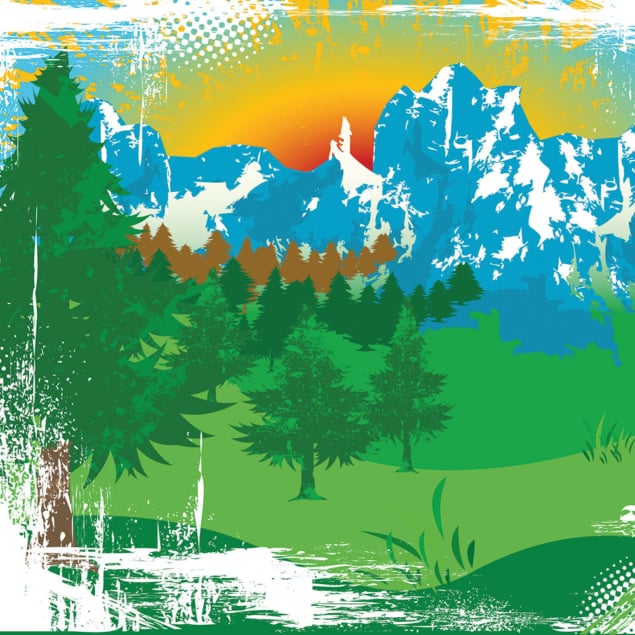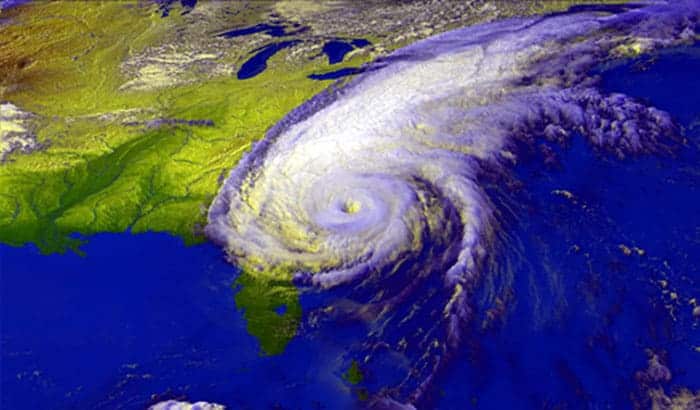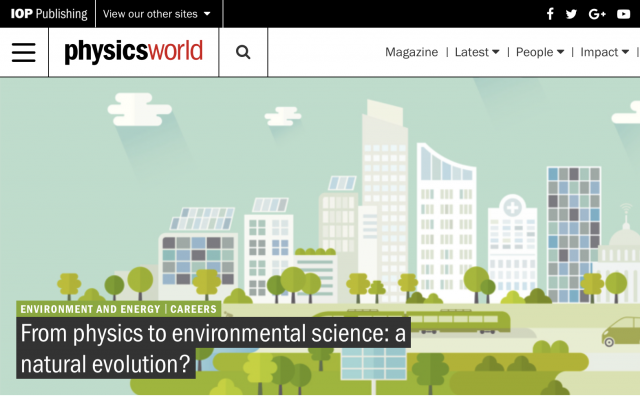Physics and environmental research are more compatible than you might first think. Kate Ravilious talks to three leading physicists-turned-environmental researchers, to find out about their journey. For the original article, click here.
How many people study physics and then go on to forge a career in environmental sciences? Perhaps not a huge number, but those who have a “physics mindset” often bring a fresh perspective to environmental research. Today an increasing number of physicists are helping to tackle some of the world’s most pressing environmental challenges. For Daniel Kammen, a self-confessed Star Trek fan and director of the Renewable and Appropriate Energy Laboratory at the University of California, Berkeley, US, the migration from physics to environmental science was serendipitous.
“My path was very random, driven by a love of physics and way too many interests,” he says. Initially, Kammen’s dream was to be an astronaut. “I learned to fly planes, took acrobatic and sea-plane landing lessons, but I was ultimately screened out of the NASA astronaut qualification on the basis of vision,” he explains. However, Kammen’s infectious enthusiasm for understanding the world around him soon opened many other doors.
While studying physics at Cornell University, Kammen learned about astronomy and cosmology, worked in the low-temperature physics laboratories and in solid-state physics, where he published his first papers on solid-state masers, and eagerly absorbed courses on electrodynamics, quantum mechanics and quantum field theory. Then at graduate school, first at Stanford University and then at Harvard University, he was drawn towards cosmology, computational physics and neural networks.
But it was while doing a postdoc in neural computing at Caltech that Kammen realized he could apply his talents to environmental problems. “During my summers I volunteered on an energy project, introducing solar ovens to communities in Nicaragua (the US was blockading the country at the time), and as a result I published my first paper on energy in Nature,” he says.
Accessing all energy
That chance volunteer work set Kammen’s career on the path of both academic and activist. For the last 25 years his focus has been finding solutions to the energy needs of developing countries. Today his passion is “energy access” and he works largely with communities in East Africa, Central America – including the country that originally inspired him, Nicaragua – and on Native American lands in the US. “Physics has provided me with the most amazing training, and I consistently use it today in work on solar cells, network studies of energy grids, and in dynamical systems methods applied to all sorts of things,” he says.
- “Physics has provided me with the most amazing training”
Dan Kammen
Stepping sideways from physics into environmental sciences has required a flexible and open-minded approach, but Kammen relishes the challenge of learning new things. “I am keen to keep working in analytical methods and I always want to learn more in the humanities and social sciences, where I am just a baby,” says Kammen, who is editor-in-chief of the open-access journal Environmental Research Letters (produced by IOP Publishing, which also publishes Physics World).
Kammen’s unusual career trajectory led him to contribute to the Intergovernmental Panel on Climate Change (IPCC) in its early days; work which was rewarded in 2007 when the IPCC shared the Nobel Peace Prize. These days his goal is to “de-carbonize” society. Last year he joined a list of eminent scientists, business leaders, economists, analysts, influencers and representatives of non-governmental organizations to set up Mission 2020 – a collaborative campaign that aims “to bend the greenhouse-gas emissions curve downwards” by 2020. Over time Kammen’s research interests have taken many twists and turns, but his enthusiasm for Star Trek is one thing that hasn’t changed. “I still own Spock ears and generally win the game ‘identify the Star Trek episode with the shortest quote’,” he laughs.
Down to Earth
For Anny Cazenave – director for earth sciences at the International Space Science Institute in Bern, Switzerland and senior scientist at the Laboratoire d’Etudes en Géophysique et Océanographie Spatiales at the French space centre (CNES) in Toulouse, France – the journey to environmental science began with an interest in what lies beyond Earth. While doing her first degree in mathematics and physics, Cazenave, like Kammen, was fascinated by space, and had ambitions of becoming an astronomer. Gradually her interests evolved towards geophysics, and she did a PhD at the University of Toulouse on the rotation of the Earth. This led to a permanent position at CNES to develop satellite geodesy – the use of satellites to study the shape of the Earth, its gravity field and its rotation, solid Earth tides and so on.

When Cazenave accepted the position, she had no inkling of how her work might transform environmental research. “At that time [the 1970s] environmental science was not at the forefront of space activities,” she explains.
It wasn’t until the mid-1990s, when satellite technology was far more advanced, that scientists began to fully explore the use of satellites for environmental applications. In particular altimeter satellites – which send a microwave pulse down to Earth and measure altitude from the time it takes the pulse to return – started employing two different wavelengths, massively increasing the resolution at which they could map the Earth’s surface.
Scientists, including Cazenave, spotted the potential of high-resolution satellites for mapping the peaks and troughs of the sea surface, and realized that they represented a new way of monitoring sea level changes and ocean circulation. “Although I was not an oceanographer, I learned about it while working,” says Cazenave. “At the beginning of the 2000s, I also started to develop hydrology from space – the study of terrestrial waters using space techniques.”
- “Interdisciplinary research needs hard work but it is highly motivating too, and I’m passionate about learning new things”
Anny Cazenave
Today Cazenave’s focus is using satellite data to monitor climate change, for example, sea level rise, land ice melt, ocean thermal expansion and changes in the global water cycle. She feels that her original background in maths and physics has been a useful tool, but flexibility and willingness to learn have also been key to enabling her to move into a new field. “Interdisciplinary research needs hard work, to gain experience in the field in which we are a newcomer, but it is highly motivating too, and I’m passionate about learning new things,” she says.
Naturally outdoors
Unlike Kammen and Cazenave who came to environmental science via curiosity about space, Jennifer Burney of the University of California, San Diego, US, found her enthusiasm for the environment to be a consistent thread throughout her life. “I’ve always been an outdoorsy person, and growing up in New Mexico always had a strong interest in the natural world,” she explains.

How hurricanes replenish their vast supply of rainwater
Following a degree in history and science, Burney began a physics PhD at Stanford, developing a superconducting camera that captures images of cosmic bodies such as pulsars or exoplanets. Partway through her studies, Burney decided to defer for a year, so that she could volunteer with rebuilding efforts in Nicaragua after 1998’s Hurricane Mitch. “It was exciting to be in the field devising creative solutions,” she says.
After finishing her PhD, Burney’s desire to bring positive change to other people’s lives resurfaced and she followed a non-academic route, working for non-governmental organization the Solar Electric Light Fund on rural electrification around the world. “One project was solar-powered drip irrigation in West Africa,” she says. “They needed somebody to figure out how to evaluate the technology. That required assessing the design and how to make it cost-effective and sustainable.”
Over time Burney became intrigued by how energy and climate affect food security, water availability and agriculture, and in 2008 she transitioned back into academia via a postdoc at Stanford on food security and the environment. Her research has continued in this vein ever since. These days Burney investigates the couplings between human activity and the environment. However, her physics mindset is still at the forefront of everything she does.
- “I fundamentally see the world as a physicist, and ultimately most of my projects have that kind of ‘flavour’”
Jennifer Burney
“I fundamentally see the world as a physicist, and ultimately most of my projects have that kind of ‘flavour’ – for example, in our projects trying to understand what role air pollutants play in impacting both climate and humans, I tend to think about how they change the radiative properties of the atmosphere and much less about the biological or chemical processes for example,” she says.
But Burney relishes the cross-disciplinary nature of her work. “You learn to see the world in a new way,” she says. And it is this willingness to see things from other people’s point of view, combined with a thirst for knowledge, that seems to have enabled Burney, Cazenave and Kammen to slide smoothly between physics and the environmental sciences. “Physics provides a fantastic toolkit, but environmental problems are the biggest challenge we have,” says Burney. “It will take all hands on deck.”
- Enjoy the rest of the March 2018 issue of Physics World in our digital magazine or via the Physics World app for any iOS or Android smartphone or tablet. Membership of the Institute of Physics required

You must be logged in to post a comment.